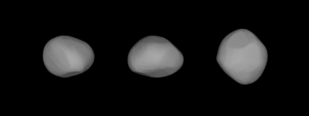(88) Thisbe
|
Asteroid (88) Thisbe |
|
|---|---|

|
|
| Form of (88) Thisbe - calculated from light reflection curves | |
| Properties of the orbit ( animation ) | |
| Orbit type | Middle main belt |
| Major semi-axis | 2,766 AU |
| eccentricity | 0.165 |
| Perihelion - aphelion | 2.309 AU - 3.223 AU |
| Inclination of the orbit plane | 5.2 ° |
| Length of the ascending node | 276.7 ° |
| Argument of the periapsis | 36.2 ° |
| Time of passage of the perihelion | June 24, 2009 |
| Sidereal period | 4 a 220 d |
| Mean orbital velocity | 17.8 km / s |
| Physical Properties | |
| Medium diameter | 232 km |
| Dimensions | (1.53 ± 0.31) 10 19 kg |
| Albedo | 0.0671 |
| Medium density | 3.44 ± 0.84 g / cm³ |
| Rotation period | 6 h 3 min |
| Absolute brightness | 7.04 likes |
| Spectral class | CF |
| history | |
| Explorer | CHF Peters |
| Date of discovery | June 15, 1866 |
| Source: Unless otherwise stated, the data comes from JPL Small-Body Database Browser . The affiliation to an asteroid family is automatically determined from the AstDyS-2 database . Please also note the note on asteroid items. | |
(88) Thisbe is an asteroid of the central main belt , which was discovered on June 15, 1866 by the German-American astronomer Christian Heinrich Friedrich Peters .
The asteroid was named after the nymph Thisbe from Greek mythology .
With a diameter of 232 kilometers, Thisbe is one of the larger asteroids in the main belt. Thisbe has a dark carbonaceous surface with an albedo of 0.067.
See also
- List of asteroids with further references and web links (see also infobox)
Web links
- Andrea Scardigli: Progetto "ASTROSCENZA": Christian Heinrich Friedrich PETERS. Archived from the original on September 27, 2007 ; Retrieved on April 23, 2004 (Italian, information about the discoverer).
- Steve Preston: IOTA / IOTA-ES occultation update for (88) Thisbe / TYC 4933-00843-1 event on 2003 Jan 28, 18:36 UT - Visible from Japan, Taiwan, SE Asia, India. International Occultation Timing Association, January 22, 2003, archived from the original on April 10, 2005 ; accessed on April 3, 2020 (English, railway data).
Individual evidence
- ↑ a b Benoit Carry Density of Asteriods , Planetary & Space Science, 2012, Volume 73, Issue 1, pp. 98–118, doi: 10.1016 / j.pss.2012.03.009
- ^ Discovery Circumstances: Numbered Minor Planets. The international Astronomical Union - Minor Planet Center, accessed August 7, 2020 .